Are you looking to bring a new furry friend home and unsure what breed? If this is you, you might be spoilt for choice, as according to the American Kennel Club, there are over 197 registered breeds. That’s not even including any crossbreeds either! Now, if you’re a fan of the Poodle, you may well be just as overwhelmed.
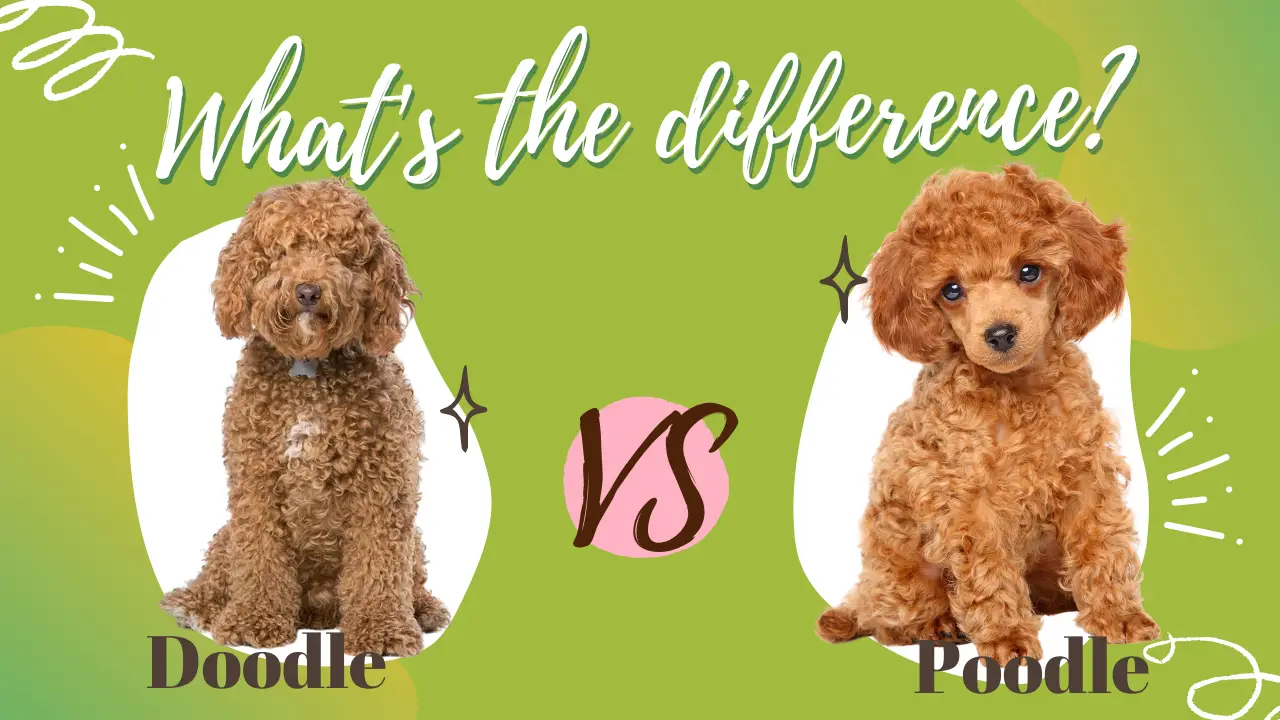
The Poodle has three main (recognized) types: Standard, Miniature, and Toy, and two that are not: the Moyen and the Teacup. Yet, while the American Kennel Club recognizes these as a breed, these dogs have over 100 different types of designer breeds known as Poodle mixes aka doodles. Doodles pretty much provide you the best of both worlds, inheriting unique qualities from two different breeds.
Regardless of owning a Poodle or a Doodle, there is a range of pros and cons to both. I can’t exactly tell you which one would be best for you, as it depends on your personal preference and circumstances.

Read our Smart Poodles - Smart Tricks eBook for only $2.99
Dive into a treasure trove of engaging tricks and tips designed specifically for your poodle!
But, to help evaluate your decision, I will cover everything you need to know about the Poodle breed and their hybrids. Expect to learn everything from their history, temperament, health problems, and more!
What Will You Learn? 👇
How to tell a poodle from a doodle?
If you’re not an expert in identifying Poodles and Doodles, it can be quite a tricky task to spot one outright if you don’t know what to look for.
The biggest difference you can notice is the coat type the doodle will inherit from its poodle parent. Chances are it’s gonna be curly.
Most of the time, a Poodle that’s been well-bred will have a square-like body that’s equal length in shoulders, whereas Doodles will not.
You can also see a slight difference between their tails. A typical Doodle has a feather-like tail, whereas a Poodle will have more of a vertical one.
There are also subtle differences when it comes to their walking. First of all, a typical Poodle will have a flowing way of walking, almost looking effortless as if they’re floating in the air. Whereas Doodles may have more clumsy tendencies and walk may look less elegant.
These are just some of the give-off visual traits that you can tell. Please, share in the comment section below, what can you notice as a difference between the poodles and various doodles.
Should you get a Doodle or a Poodle?
Now, if you’re stuck between the two, there’s no definite answer which can help you choose a Doodle or Poodle. There are some contrasts between these dogs which might suit your living or preferences better.
For instance, some have different lifespans, some of the dogs have more energy, different personalities, and more. So, therefore, it’s hard to say which would be better for your household. However, in this case, it’s best to look at everything about a Poodle and Doodle to better your decision.
Pros/cons of getting a Poodle
There’s a variety of advantages and disadvantages to getting a Poodle. To know them, you must look at their history, temperament, and health problems they experience.
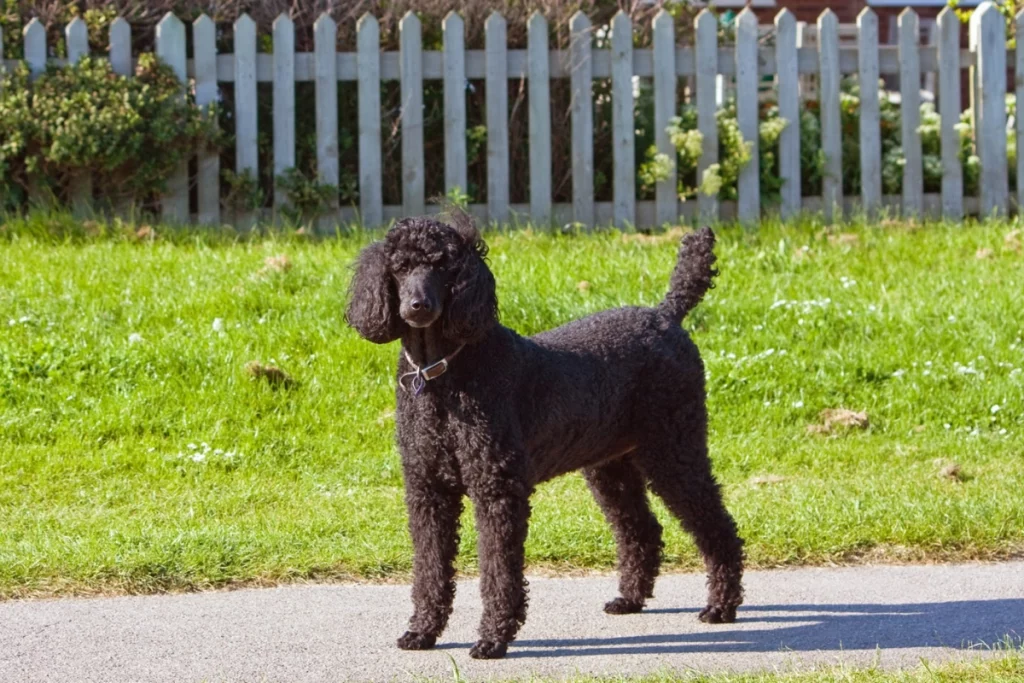
History
Poodles are a lot older than you think. This breed originated around the 13th century in Germany and was primarily kept to hunt waterfowl, mainly ducks and birds.
Their name is English for ‘Pudel,’ and in German, it means to” Splash in the water”.
Back then, Poodles certainly did splash, too, as they were fast swimmers, and their hair made them streamlined in the water. While their retrieval was popular, the popularity of the Poodle spread to France. In the 14th century, many breeders started to make smaller Poodles of the Poodle, such as the Toy and Miniature. Due to their multiple purposes, the Poodle became the national dog of France.
Their primary purpose was to benefit upper-class Parisians as accessories on their arms. Similarly, Miniature sized Poodles were used in Paris to help sniff out truffles in the wood. Circus performers also liked to utilize the Poodles in intelligence, taking them around traveling getting them to perform tricks at their shows.
While the Miniature and Toy Poodle have been mainly kept as lapdogs, the Standard Poodle has been commonly used in the US and Canada since the 1990s as hunters. Nowadays, the Poodle is more domesticated and not a retriever breed.
Temperament
Poodles are known as one of the smartest dogs in the world; they always are in the top 10 polls on blogs and rankings when it comes to dog intelligence. It’s believed that their intelligence is often almost human-like. Because of their smart nature, they can be quick to pick up skills and tricks, making them great learners.
These dogs don’t have any aggressive traits in them either, as long as they’re socialized from an early age. Because of this, they’re a great breed to own if you have children, as they’re harmless, love to play, and shower them with affection. In addition to their loyalty, it’s often advised they don’t get left alone for long periods in a room as they can suffer from separation anxiety.
Regarding their housing, they’re a breed that can live in flats or apartments. However, they may be better suited to a larger home with a yard for physical and mental stimulation.
Moreover, Poodles prefer hotter temperatures than colder ones because their coat isn’t thick enough to acclimatize to them appropriately.
Health risks
On average, a Poodle can live up to 12-15 years. However, throughout their lifetime, they can be prone to some health problems such as:
- Addison’s disease
- Gastric dilation volvulus (bloat)
- Cushing’s disease
- Hip dysplasia
- Epilepsy
- Progressive renal atrophy
- Patellar luxation
- Von Willebrands disease
- Certain cancers
Therefore if you’re looking to buy a Poodle, you must visit a recognized breeder to see the Puppy’s health. A qualified breeder will show you health certificates for the Poodles parents.
Pros/ cons of getting a Doodle
There are a lot of advantages to getting a Doodle. To help you know more, let’s look at the following:

History
Unlike its parent, the Doodle is a relatively new hybrid breed coming into existence in the 1980s. The first Doodle was bred by Wally Conron, who worked as a puppy breeding manager for the Royal Guide Dog Association of Australia. At the time, Conlon’s goal was to make a dog close enough to be allergy-free which helped visually impaired women who suffered from allergies relating to dog dander.
After 33 attempts and two years, the first Doodle was born, a cross between the Standard Poodle and Labrador. In the next few years, Doodles became more popular, with many breeders trying to market them as “hypoallergenic” dogs to make that extra bit of money.
Temperament
Now regarding a Doodles temperament, they’re pretty vast! After all, just think about the different parents they can have alongside the Poodle. There are at least around 100 different combinations! One thing for sure that they definitely get through is the Poodle’s intelligence making them a dog that loves to learn.
Doodles are renowned for being extremely loyal to their families most of the time. This means they’re a great family pet and can easily bond to the younger and older generation. They thrive off a human company and don’t do well on their own for long periods. As long as they have someone around, they’re quite the obedient breed.
On the contrary, if you’re looking for a strong guard dog, you won’t want to own a Doodle. They might bark to notify you of an intruder or stranger, but that’s the most they will do.
It’s unlikely they will attack or showcase aggressive tendencies instead; they’re more likely to roll over and have their belly rubbed. In addition to this, they are sometimes described as lazy dogs and not as active as the Poodle. But, again, it all depends on the traits they inherit from either parent! To know more, it’s probably best you speak to a Doodle breeder if you’re looking to get a specific Doodle.
Health Risks
On average, the lifespan of a Doodle can range between 12-15 years. Most of the time, they are medium to large-sized breeds. When it comes to their health, though, you can’t always identify potential risks for all of the Doodles, as it depends on their genes from their parents. But there are some common health risks Doodles may face, such as:
- Progressive Renal Atrophy
- Hip Dysplasia
- Atopic Dermatitis
What does F1, F1b, F2, F3 mean?
If you’re looking to buy a hybrid breed like the Doodle, you must know the terms used in the industry. Based on the type of crossbreed, they’re commonly referred to as F1, F1b, F2, and F3.
When you see these letters, don’t be alarmed by them, though. They’re an indicator of the different generations of a Doodle. F1 means that this is the first generation offspring between another breed and a Poodle. The F stands for “Filial Hybrid”, while the number is the generation of the dog. 1 means first generation, 2 means second generation, 3 means third generation, etc. Some doodles have a “B” at the end of their names. This indicates that they are a backcross: a doodle bred to a poodle.
- F1: An F1 breed results from two different dogs being bred together to form a doodle. For example, 50% is from the Poodle parent, and 50% is from the other breed. An example of this is a Poodle bred with a Labrador to form a Labradoodle, F1.
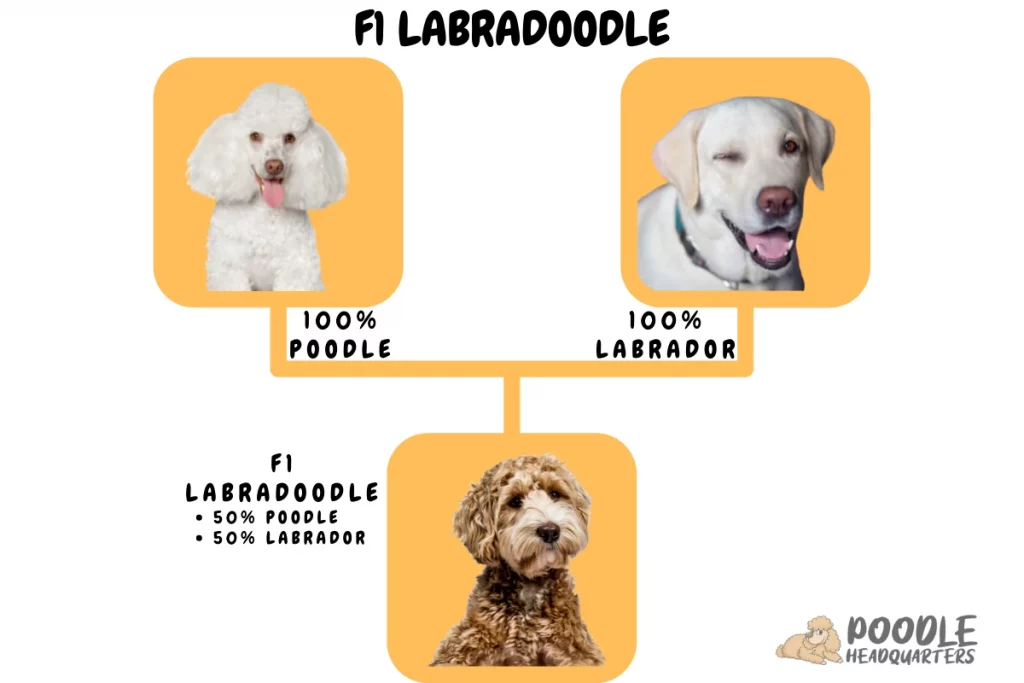
- F1b: Now, these dogs result from a purebred parent like the Poodle being bred with a F1 crossbreed such as the Labradoodle. This combination together is known as F1b.
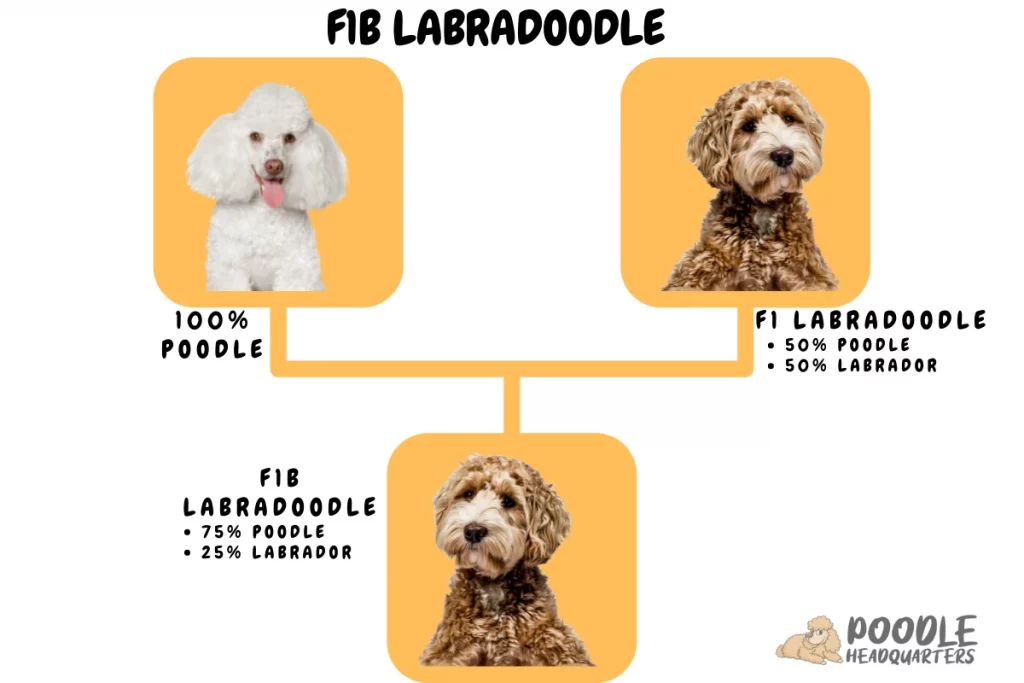
- F2: These are a combination of two F1 hybrids dogs being bred to make the F2.
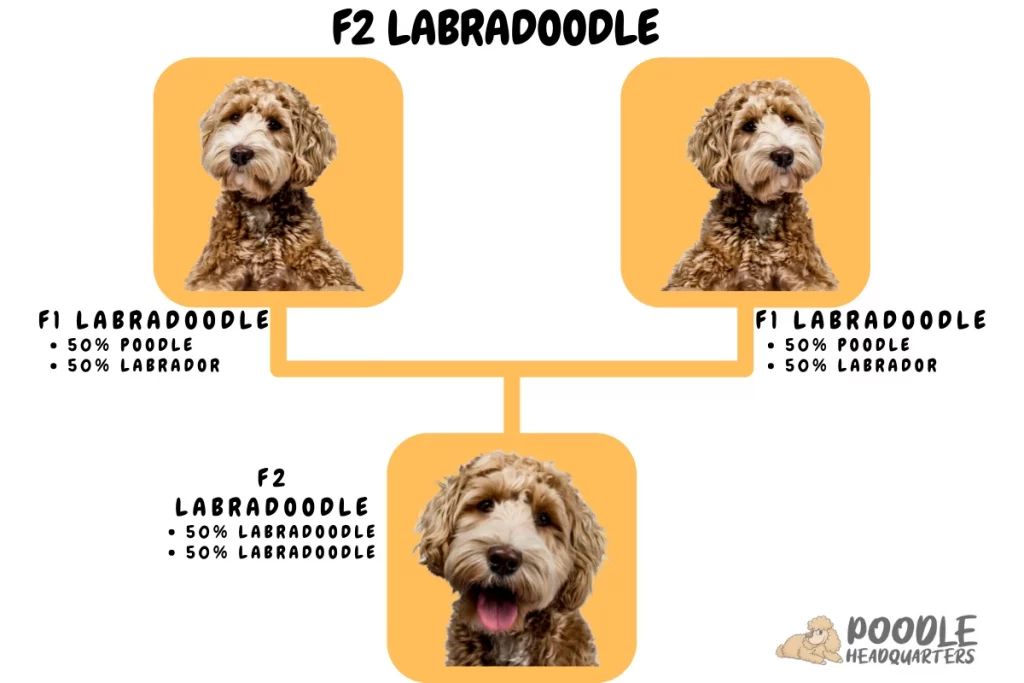
- F3: These are dogs where two F2 parents are mated together. Technicly this will be the third gen doodle.
What is Double Doodle?
In case you haven’t figured already, two types of Doodles can actually go on to produce a new different doodle crossbreed. In this context, it’s known as the Double Doodle. But just because it’s a Double Doodle does not guarantee that they have a split 50/50 inheritance pattern. It’s more likely they will have a large mix of traits due to them being crossbred multigenerational canines.
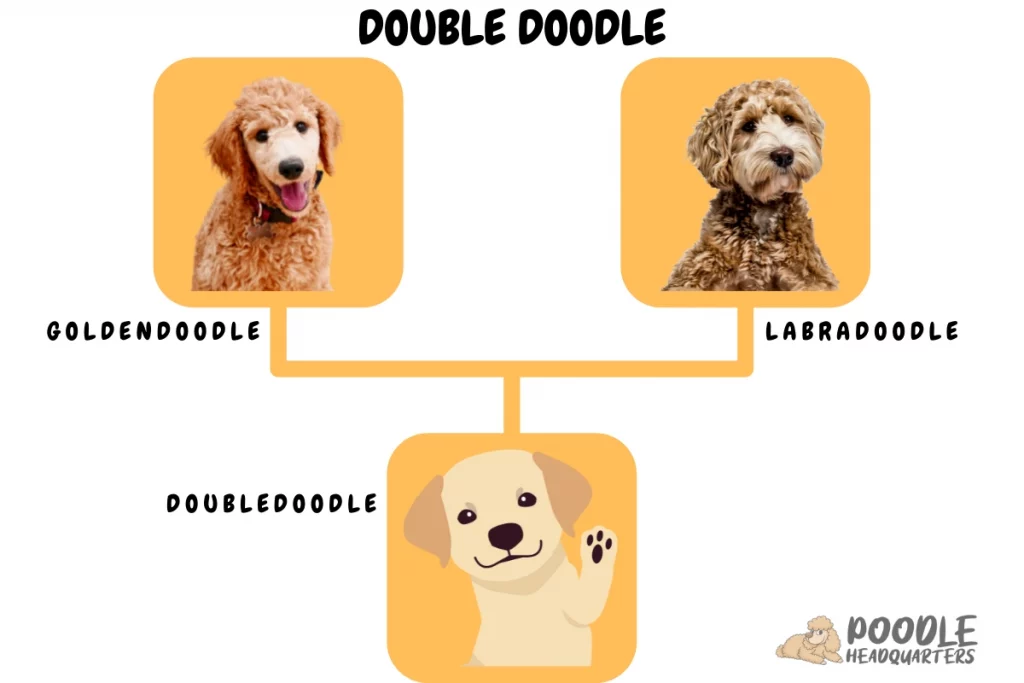
It’s also important to know that the potential mixing of breeds for the Double Doodle can cause a vast range of temperaments and health problems. Because of this, it can be really difficult to identify the dog in itself. Therefore, if you are planning on getting a Double Doodle, you must trace their lineage and thoroughly look at their ancestors’ personalities and health conditions.
Fun Facts
- Doodles, especially Golden Doodles, are not expensive to look after when it comes to grooming. Most Doodles have low shedding qualities, which means your grooming bills won’t rake up in cost!
- Even though they’re bred with a range of crosses, Double Doodles tend to have the same lifespan as a Poodle.
Conclusion
Overall, whether you want a Doodle or Poodle in your life, they’re both excellent dogs to own. They both hardly ever shed and, therefore, are likely to have less danger of triggering allergies. Both are not aggressive; they love families, making them perfect for first-time dog owners.
Their sizes, temperaments, appearance, and health conditions are the only main differences between them. Regarding these, there are no right options to choose from; it’s up to you as a potential Poodle or Doodle owner to decide this.
One thing is for sure, though, always make sure you speak to the breeder or shelter before buying so you have a good insight into the dog before you bring them home.
What would you prefer, a Poodle or a Doodle? Let us know in the comments down below.
Marko is the founder and author at PoodleHQ, where he blends profound expertise with formal training in Animal Behavior and Canine Genetics. With multiple generations of poodles under his care, he’s a breed connoisseur, honored with the Canine Care Excellence Award and lauded by the International Pet Enthusiasts Association.


Can someone please help me find a mini Chowdoodles???
Hey Rena.
My best bet on where you can find a Chowdoodle is under the #chowdoodle hashtag on Instagram, and contact the people that own one.
Also check out the post I wrote on Chowdoodles here: https://poodlehq.com/chow-doodle-chow-chow-poodle-mix/